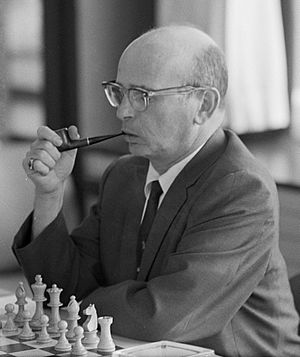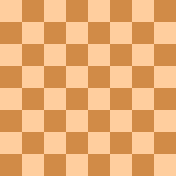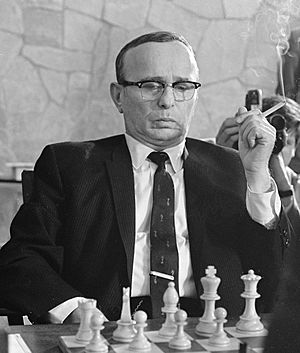Samuel Reshevsky facts for kids
Quick facts for kids Samuel Reshevsky |
|
|---|---|

Reshevsky in 1964
|
|
| Full name | Samuel Herman Reshevsky |
| Country | United States (after 1924) Poland (before 1924) |
| Born | November 26, 1911 Ozorków, Congress Poland, Russian Empire |
| Died | April 4, 1992 (aged 80) New York City |
| Title | Grandmaster |
| Peak rating | 2565 (July 1972) |
Samuel Herman Reshevsky (born Szmul Rzeszewski; November 26, 1911 – April 4, 1992) was an amazing chess player. He was born in Poland and later became a top American grandmaster. A grandmaster is the highest title a chess player can achieve.
Samuel was known as a chess prodigy because he was incredibly good at chess from a very young age. He was one of the best players in the world from the 1930s to the 1960s. He even competed for the World Chess Championship title. Samuel won the US Chess Championship eight times, which is a record he shares with another famous player, Bobby Fischer. Besides playing chess, he worked as an accountant and wrote books about chess.
Contents
Early Life and Chess Beginnings
Samuel Reshevsky was born in a town called Ozorków in Poland. He was part of a Jewish family. He started playing chess when he was only four years old. Everyone quickly saw that he was a child genius at the game. By the time he was eight, he could easily beat many experienced chess players. He even gave "simultaneous exhibitions," where he played many games at the same time against different people.
In 1920, his parents moved to the United States. They wanted to show off their son's amazing talent. Samuel played thousands of games in exhibitions across the country. He even played in a big tournament in New York in 1922. He was probably the youngest player ever in such a strong competition.
For a while, Samuel did not go to school. His parents had to go to court because of this. But then, a rich businessman named Julius Rosenwald became Samuel's helper. He promised to support Samuel's future if Samuel finished his education.
Samuel never became a full-time professional chess player. He took a break from most chess tournaments for seven years (1924-1931) to finish school. He still played in some events during this time. In 1934, he graduated from the University of Chicago with a degree in accounting. He worked as an accountant to support himself and his family. He lived in New York City for the rest of his life with his wife, Norma Mindick, and their three children. Samuel was a religious Jew. This meant he would not play chess on the Sabbath (Saturday) or on major Jewish Festivals. His games were always scheduled around these times.
Later Life and Passing
Samuel Reshevsky passed away on April 4, 1992, in Suffern, New York. He was 80 years old.
Samuel's Chess Career
Achievements in the United States
Samuel Reshevsky won the US Open Chess Championship in 1931. He also shared the title in 1934. He became the US Chess Championship champion in 1936, 1938, 1940, 1941, 1942, 1946, and 1969. He tied for first place again in 1972 but lost in a playoff. He played in the US Championship a record 21 times. He always had a winning record, except for one time. He also holds records for finishing in the top three places most often (15 times). He played the most games (269) and won the most games (127) in the US Championship.
International Successes
| This section uses algebraic notation to describe chess moves. |
Samuel's international chess journey started in 1935. He won a tournament in England. Then, he won another tournament in Margate, England. There, he famously beat José Raúl Capablanca, who was a former world champion. Here is how that game went:
| a | b | c | d | e | f | g | h | ||
| 8 |

|
8 | |||||||
| 7 | 7 | ||||||||
| 6 | 6 | ||||||||
| 5 | 5 | ||||||||
| 4 | 4 | ||||||||
| 3 | 3 | ||||||||
| 2 | 2 | ||||||||
| 1 | 1 | ||||||||
| a | b | c | d | e | f | g | h | ||
- Reshevsky vs. Capablanca, 1935
1.d4 Nf6 2.c4 e6 3.Nc3 d5 4.Bg5 Nbd7 5.cxd5 exd5 6.e3 Be7 7.Bd3 0-0 8.Qc2 c5 9.Nf3 c4 10.Bf5 Re8 11.0-0 g6 12.Bh3 Nf8 13.Bxc8 Rxc8 14.Bxf6 Bxf6 15.b3 Qa5 16.b4 Qd8 17.Qa4 a6 18.b5 Re6 19.Rab1 Rb8 20.Rb2 Be7 21.bxa6 Rxa6 22.Qc2 Ne6 23.Rfb1 Ra7 24.a4 Nc7 25.Ne5 Qe8 26.f4 f6 27.Ng4 Qd7 28.h3 Kg7 29.Nf2 Ba3 30.Ra2 Bd6 31.Nfd1 f5 32.Nb5 Ra5 33.Nxc7 Bxc7 34.Nc3 Qd6 35.Qf2 b6 36.Qf3 Rd8 37.Rab2 Qe7 38.Rb4 Rd7 39.Kh1 Bd8 40.g4 fxg4 41.hxg4 Qd6 42.Kg1 Bc7 43.Kf2 Rf7 44.g5 Bd8 45.Ke2 Bxg5 46.Rxb6 Qa3 47.Kd2 Be7 48.Rb7 Rxa4 49.Qxd5 Ra5 50.Qxc4 Rh5 51.Kd3 Qa8 52.Qe6 Qa3 53.Rd7 Rhf5 54.Rb3 Qa1 55.Rxe7 Qf1+ 56.Kd2 1–0
In 1936, Samuel finished third in a big tournament in Nottingham. In 1937, he shared first place in Latvia. In 1938, he shared fourth place in the famous AVRO tournament in the Netherlands. This tournament had eight of the world's strongest players.
Samuel was a serious contender for the World Championship for many years. In 1948, he was one of five grandmasters to play in the World Championship tournament. He finished in a tie for third place. This tournament was held because the previous World Champion, Alexander Alekhine, had passed away.
In 1950, Samuel was given the title of International Grandmaster by FIDE, the World Chess Federation. This was the first time FIDE gave out these titles. He did not play in the 1951 Candidates Tournament. Some people thought it was because of political reasons during the Cold War. However, Samuel later said that it was his own choice not to go.
The next Candidates Tournament in Zurich in 1953 was a big chance for Samuel. He finished in a tie for second place. Some players later said that there was a plan among the Soviet players to stop Samuel from winning. They wanted a Soviet player to win instead.
Samuel qualified for another Candidates Tournament in 1967. But he lost his match in the next round.
Playing for His Country
Samuel played for the US team eight times in the Chess Olympiads. These are big international team tournaments. He played on the top board six times over 37 years. He helped the US team win a gold medal in 1937 and a bronze medal in 1974. He also won an individual bronze medal for his performance in 1950. He played in Olympiads in 1937, 1950, 1952, 1958, 1964, 1968, 1970, and 1974.
Match Play
Samuel was very good at playing chess matches against single opponents. In 1952, he played a match against Miguel Najdorf. Samuel won the match 11–7. He won a rematch against Najdorf the next year too.
He won many other matches throughout his career. For example, he beat Israel Albert Horowitz in 1941 and Isaac Kashdan in 1942. He also defeated Svetozar Gligorić in 1952 and William Lombardy in 1956.
Samuel lost his first match in 1964. This was a short playoff match against Lajos Portisch. Samuel didn't have much time to prepare for it. Portisch was a full-time chess player and very good at preparing his opening moves. Samuel was at a disadvantage and lost the match.
In 1955, Samuel played on the top board for the US team against the USSR in Moscow. He played against the World Champion, Mikhail Botvinnik. Samuel won one game and drew three, winning their mini-match.
Rivalry with Bobby Fischer
When Bobby Fischer started playing in the US Championship at age 14, he became very dominant. He won every time he played, leaving Samuel behind. There was a strong rivalry between the two players, who were a generation apart in age. Before a tournament in Buenos Aires in 1960, Samuel reportedly joked, "I would settle for 19th place – if Fischer placed 20th." Samuel actually won that tournament, and it was the only time he finished ahead of Fischer in an international event.
In 1961, Samuel started a 16-game match against Fischer. After eleven games, the score was tied. The match ended early because of a disagreement about scheduling. Samuel received the prize money for the winner.
In a 1967 tournament, Fischer arrived very late for his game with Samuel. Samuel was upset and lost the game. Despite losing that game, Samuel still moved on to the next stage of the tournament. Samuel also refused to play for the US team in some Chess Olympiads because Fischer was chosen for the top board instead of him. However, they did play on the same team in 1970.
Even though they had a fierce rivalry, Fischer respected Samuel. Fischer once said that he thought Samuel was the strongest player in the world in the mid-1950s. This was around the time Samuel beat World Champion Mikhail Botvinnik.
During his long career, Samuel Reshevsky played against 11 of the first 12 world champions. He is the only player to have done this. He defeated seven world champions: Emanuel Lasker, José Raúl Capablanca, Alexander Alekhine, Max Euwe, Mikhail Botvinnik, Vasily Smyslov, and Bobby Fischer.
Major Tournament Wins
Besides his US Championship titles, Samuel won many other important tournaments:
- Syracuse 1934
- Hastings 1937–38
- Leningrad/Moscow 1939
- Hollywood 1945 (Pan American Championship)
- New York 1951
- Havana 1952
- New York 1956
- Dallas 1957
- Haifa/Tel Aviv 1958
- Buenos Aires 1960
- Netanya 1969
- Reykjavík Open 1984 (at age 72!)
Samuel continued to play chess seriously almost until his death in 1992. He even defeated his old rival Vasily Smyslov in a tournament game in 1991.
Samuel's Playing Style
Samuel Reshevsky was a strong and determined player. He was excellent at "positional play," which means understanding how to place pieces well on the board. But he could also play brilliant "tactical chess," which involves clever combinations of moves. He often spent a lot of time thinking in the beginning of his games. This sometimes meant he had to play the rest of the game very quickly. This could make his opponents nervous, but sometimes it also led to mistakes from Samuel. Some people believe his slow starts and tendency to run out of time might have stopped him from becoming world champion.
Samuel often started his games with the white pieces using "closed openings," usually by moving his pawn to d4. He was especially good with a specific opening called the Exchange Variation of the Queen's Gambit Declined. He rarely started with 1.e4 against strong players. With the black pieces, he used many different types of openings.
Another American grandmaster, Arnold Denker, said that Samuel had amazing determination and fighting spirit. He noted that Samuel had an advantage over his main American rival, Reuben Fine. This was especially true in the US Championships from the 1930s to the 1940s. Reuben Fine often struggled in games against Samuel, which was a big reason why Fine never won the US Championship.
Books by Samuel Reshevsky
Samuel wrote several books about chess, sharing his knowledge and experiences:
- Reshevsky on Chess (1948)
- How Chess Games Are Won (1962)
- Great Chess Upsets (1976)
- The Art of Positional Play (1978)
He also wrote about the 1972 World Championship match between Bobby Fischer and Boris Spassky. Samuel wrote articles for chess magazines like American Chess Bulletin and Chess Life. He also wrote for The New York Times.
See also
 In Spanish: Samuel Reshevsky para niños
In Spanish: Samuel Reshevsky para niños
- List of Jewish chess players





